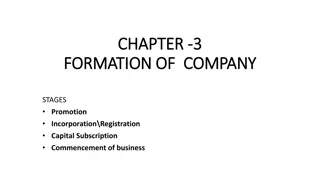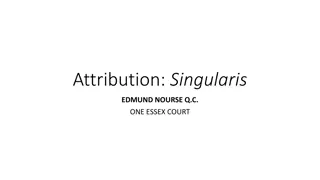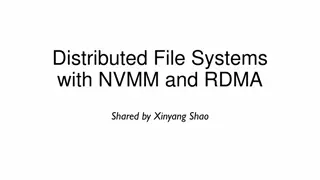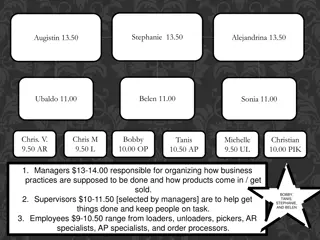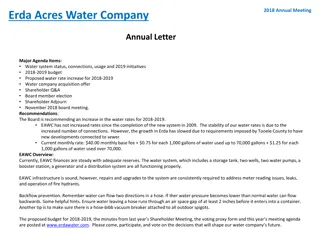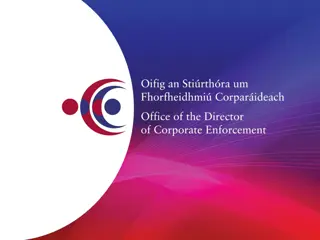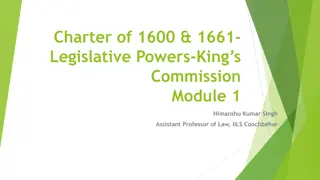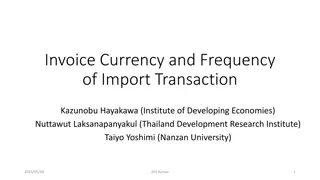Understanding Company Incorporation and Its Implications
Explore the definition of a company, its characteristics, advantages, disadvantages of incorporation, and the concept of independent corporate existence through landmark cases like Salomon vs. Salomon & Co. Ltd. Gain insights into the legal structure, responsibilities, and implications of forming a company in the business world.
Download Presentation

Please find below an Image/Link to download the presentation.
The content on the website is provided AS IS for your information and personal use only. It may not be sold, licensed, or shared on other websites without obtaining consent from the author. Download presentation by click this link. If you encounter any issues during the download, it is possible that the publisher has removed the file from their server.
E N D
Presentation Transcript
COMPANY- INTRODUCTION Definition of Company Sec.2(20) a company incorporated under this Act or under any previous company law Lord Justice Lindley- an association of many persons who contribute money or money s worth to a common stock and employ it in some trade or business, and who share the profit and loss arising therefrom. The common stock so contributed is denoted in money and is the capital of the company. The persons who contribute it ,or whom to it belongs, are members. The proportion of capital to which each member is entitled is his share. Shares are always transferable although the right to transfer them is often more or less restricted Prof. Haney- an incorporated association , which is an artificial person created by law, having separate legal entity, with a perpetual succession and a common seal
Characteristics of Companies Characteristics of Companies S separate legal identity- juristic persona distinct from members E easy entry and exit option- due to transferability of shares I incorporated association- registration is compulsory N number of members- min. 2 and 7 for pvt. and public co.,; max. 200 and no limit for pvt and public co. A artificial person- created by law through legal process and brought to end also by legal process; has nationality, domicile but not citizenship. P perpetual existence- members may come and go but company continues M management by BOD who are elected representatives of members O ownership is diffused- ownership of company is scattered over large number of persons C common capital with limited liability and common seal- common seal is optional
Disadvantages of Incorporation Disadvantages of Incorporation Formality and the expense Loss of privacy Wastages and inefficiency
Independent Corporate Existence/ Separate Legal Independent Corporate Existence/ Separate Legal Identity Identity Salomon vs Salomon & Company Ltd. Abdul Haq vs Dass Mal Re. Kondoli Tea Co. Ltd. Lee vs Lee Air Farming Limited Macaura vs Northern Assurance Co. Lmt.
Salomon vs Salomon &Co.Lmt Saloman was a prosperous leather merchant who sold his business for the sum of 30,000 to Salomon&Co.Lmt ,which consisted of Salomon himself, his wife and daughter and his four sons. The purchase consideration was paid by the company by allotment of 20,000 fully paid 1 shares and 10000 secured debentures having charge on the assets of the company, to Mr.Salomon. One share of 1 each was subscribed for in cash by the remaining six members of his family. Salomon was the managing director of the company and as he held virtually the whole of its stock, he had absolute control over the company. Only a year later, the company became insolvent and winding up commenced. At that time, the statement of affairs was roughly like this : Assets 6000 ; Liabilities 10000(secured debentures of Salomon)and 7000(unsecured creditors).Thus, its assets were running short of its liabilities by 11000. The unsecured creditors claimed priority over the debenture holder(Salomon) on the ground that a person cannot owe to himself and that Salomon and the company were one and the same person. They further contended that the company was a mere alias or agent for Salomon, the business was solely his, conducted solely for him and by him and the company was a sham, and fraud ,hence Salomon was liable to indemnify the company against its trading debts. But the House of Lords held that the existence of a company is quite independent and distinct from its members and that its assets must be applied first in payment of the secured debentures and then afterwards to unsecured creditors.
Abdul Haq vs Das Mal Abdul was an employee in a company. He had not been paid his salary for several months. He sued Das Mal, a director of the company for recovery of the amount of salary due to him. It was held that since the company was a separate legal entity from its members, he would not succeed. The remedy lies against the company and not against the directors or members of the company. Re. Kondoli Tea Co. Ltd. Some persons owned a tea estate. They transferred it to a company. They claimed exemption from ad valorem duty on the ground that it is simply a transfer from them to themselves under a different name.The court did not accept the contention and observed that the company was a separate body altogether from the shareholders and the transfer was as much a conveyance, a transfer of property as the shareholders had been totally different persons.
Lee vs Lee Air Farming Limited Lee formed a company in which out of total 3000 shares, Lee himself was holding 2999 shares. He was the managing director and also the Chief Pilot of the company ,appointed on a salary. Lee died during the course of his employment in an aircrash. His widow claimed compensation under the Workmen s Compensation Act. It was argued that no compensation was due as Lee and Lee Air Farming Limited was the same person. But the Privy Council held that Lee and the company were not one and the same person. They were two distinct legal entities which had contractual relationship under which Lee became an employee of the company and since he died while in the course of employment , compensation was payable to him.
Macaura vs Northern Assurance Co. Lmt. Macaura , the owner of a timber estate sold all the timber to a registered company in exchange for shares in the company. He was the holder of nearly all the shares, except one, of a timber company. He was also the major creditor of the company. The timber continued to be insured in Macaura s name personally, rather than in the name of the company. The timber was destroyed by fire after a while. It was held that the insurance company is not liable to compensate Macaura as he had no insurable interest in the property. The timber was the property of the company and belonged to the company only.
Perpetual Succession Re. Meat Suppliers (Guildford)Limited During the war, all the members of one private company , while in general meeting, were killed by a bomb. But the company survived: not even a hydrogen bomb could have destroyed it. The legal heirs of the deceased members will become members of the company by transmission of shares and so the company will continue ..
PARTNERSHIP FIRM VS COMPANY BASIS PARTNERSHIP FIRM COMPANY Capital The capital of a firm can be changed be changed by the mutual consent of the partners Capital of a company can be altered by following the procedure laid down by the Companies Act,2013. Property The partnership property belongs to all the partners. The property of the company belongs to the company and not to the members. Management Every partner is entitled to take part in the management of the firm. The right to control and manage the business is vested in the Board of Directors elected by the shareholders. Agency Every partner is an agent of the firm and can bind the other partners and the firm by his acts. A member is not an agent of the company or of other members. Audit Audit of accounts is not compulsory Audit of accounts is compulsory. Annual Return No return to be filed Annual Return to be filed with ROC compulsorily Nature of document Partnership deed is a private document Memorandum of Association and Articles of Association are public documentss
PARTNERSHIP FIRM VS COMPANY BASIS PARTNERSHIP FIRM COMPANY Regulating Act A firm is governed by the Indian Partnership Act, 1932 A company is governed by the Companies Act,2013 Registration A partnership may or may not be registered . A company must be registered. Name There are no provision in the Partnership Act,1932 regarding the last words of the name of the firm. It is mandatory to use the words limited or private limited" at the end of the name of a public or private company respectively. Legal Status A partnership firm does not have distinct legal entity separate from the its partners. The partners collectively are called firm A company is an artificial person and has a distinct legal entity separate from its members. Number of members Minimum -2 Maximum-50 Minimum 2 & maximum 200 in private co. Minimum 7 & maximum no limit in public Business A partnership firm can engage in any lawful business which the partners like. A company can engage in only those lawful businesses as are mentioned in the objects clause of its MOA. Liability The liability of the partners is unlimited. The liability of shareholders is limited to the extent of amount unpaid on shares held by them
PARTNERSHIP FIRM VS COMPANY BASISs PARTNERSHIP FIRM COMPANY Transfer of interest A partner cannot transfer his interest in the firm without the consent of all other partners. The shares of a public company are freely transferable while shares of a private company can be transferred Perpetual existence It does not have perpetual existence . It has perpetual existence i.e. its life is not affected by the death or insolvency of any member/director Dissolution A firm may be dissolved with the mutual consent of all the partners. A company is dissolved by following a due process of law. Separation of owners from management There is no separation of management from owners There is separation of management from owners Issue of shares to public It cannot issue shares or debentures to raise funds from public Public company can issue shares to public to raise funds Meetings Not specified. Partners can hold meetings as and when they wish. Board meetings must be held quarterly and Annual General Meeting must be held every year.
Company vs Body Corporate The term body corporate means body which has been incorporated under any statute has perpetual succession has an entity distinct from its members. A company is a body corporate because it has all the above attributes i.e. the persons composing it are made into one body by incorporating it as per the law of the land, it has perpetual succession and it is clothed with legal personality distinct from its members. But the term body corporate is much wider in concept than the word company because it includes Companies formed and registered under Companies Act Companies incorporated outside India i.e. foreign companies Corporations formed under Special Acts ( of Indian / Foreign Parliament) Public financial Institutions Nationalised Banks Limited Liability Partnerships ( Indian/ Foreign)
Lifting of Corporate Veil Lifting of Corporate Veil ( (Also exceptions to Salomon Case) exceptions to Salomon Case) Under Judicial Interpretations Also known as known as Avoidance of Welfare Legislation(Workmen of Associated Rubber Industry Ltd. Vs. Associated Rubber Industry Ltd.) Benefit of Revenues(Re. Sir Dinshaw Maneckjee Petit) Company acting as agent of another company(Merchandise Transport Ltd Vs. British Transport Commission) Determination of character of Company (Daimler Co. Ltd. Vs. Continental Tyre and Rubber Co.) Evasion of Statutory and personal obligation (Jones Vs. Lipman) Fraud or Improper Conduct(Gilford Motor Co. Vs. Horne.)
Workmen of Associated Rubber Industry Ltd. Workmen of Associated Rubber Industry Ltd. Vs. Associated Rubber Industry Ltd Vs. Associated Rubber Industry Ltd. . A' limited purchased shares of 'B' limited by investing a sum of Rs.450000. The dividend in respect of these shares was shown in P& L Account of the company, year after year. It was taken into account for the purpose of calculating the bonus payable to the workmen of A limited. Sometime in 1968, A limited transferred the shares of B limited , to C limited, a subsidiary wholly owned by it. Thus, the dividend income did not find place in the P&L account of A limited, with the result that the surplus available for the purpose of payment of bonus to the workmen got reduced. Here, A limited created a subsidiary and transferred to it , its investment holdings in a bid to reduce its liability to pay bonus to the workers. Thus, the Supreme Court held that the separate existence of the new company would be disregarded for the purpose of working out the amount of bonus payable
Re. Sir Re. Sir Dinshaw Dinshaw Maneckjee Maneckjee Petit Petit The assessee, D, was a millionaire enjoying huge dividend and interest income . He formed four private companies and transferred his investments in parts to each of these companies in exchange of their shares. Now the companies received the dividend and interest income but they handed back the amount to him as a pretended d loan. This way he divided his income in four parts for reducing his tax liability. It was held that the company was formed by the assessee purely for avoiding tax and the company was nothing more than the assessee himself. It did no business but was created simply as a legal entity to ostensibly receive the dividends and interests and to hand them over to the assessee as pretended loans
Merchandise Transport Ltd Vs. British Merchandise Transport Ltd Vs. British Transport Transport Commission Commission A transport company wanted to obtain licences for its vehicles, but was not entitled to apply in its own name. Therefore, it formed a subsidiary company and application for licences was made in the name of the subsidiary. After obtaining the licences, they were to be transferred to the parent company. The application for licences was rejected. On a suit filed by the subsidiary company against the licensing authority, the court held that a licensing authority was entitled to treat the parent company and the subsidiary company as one commercial unit so as to prevent the misuse of the licensing scheme.
Daimler Co. Ltd. Vs. Continental Daimler Co. Ltd. Vs. Continental Tyre Rubber Co. Rubber Co. Tyre and and In this case, a company was incorporated in England for the purpose of selling there the tyres manufactured in Germany by a German Company. Its majority shareholders and all the directors were Germans resident in Germany. Thus, the real control of the company was in German hands. During World War I, the company brought a case to recover a trade debt. Since during the wartime,the persons in defacto control of the company became alien enemies , the company was declared to be an alien company. Therefore,the court dismissed the case and observed that such payment would be trading with the enemy and to allow alien enemies to trade under the corporate facade will be against public policy.
Jones vs Lipman Lipman had contracted to sell his land to Jones. He subsequently changed his mind and requested Jones to be released from the contract . Jones did not agree to this. As such , with an object to avoid specific performance of the contract, Lipman sold the land to a company which was formed specially for the purpose. Lipman and a clerk of his solicitor were the only shareholders and directors of the newly formed company. Jones brought an action for the specific performance against Lipman and the company. The court looked into the reality of the situation, ignored the transfer deed in favour of the company, and ordered specific performance against Lipman and the company both on the ground that the company was a mere cloak for Lipman. The company was denied to have juristic personality distinct from its members and thereby the corporate veil was lifted to frustrate the attempt of Lipman to avoid his obligation under the contract.
Gilford Motor Company vs. Horne Horne was appointed as a managing director of Gilford Motor Company under an agreement of service which inter alia contained a condition that Horne shall not solicit away the customers of the company. Shortly afterwards, Horne formed a company which solicited the Gilford Motor company's customers. It was held that the newly formed company was a mere cloak or sham for the purpose of enabling Horne to commit a breach of his non-solicitation clause. Hence, the corporate veil was lifted and Horne and his company were restrained from enticing away Gilford Motor company's customers
Lifting of Corporate Veil Lifting of Corporate Veil Under Statutory Provisions Fall of membership below statutory minimum (3A) Governmental investigation into ownership of a company (Sec.216)- to find true persons who are financially interested in a company and who control\materially influence its policy Holding and Subsidiary Company Relationship (Sec.129) Investigating the affairs of a related company under same management\group(Sec.219)- for alleged fraud, oppression and mismanagement Jyada Karo Liability under other statutes- directors may be personally held liable for default (under FEMA, ESI,etc.) Misrepresentation in Prospectus (Sec.34 &Sec.35) Non repayment of application money(Sec.39 and SEBI Guidelines) Preincorporation Contracts
Reverse Piercing Reverse Piercing Sometimes it is to the advantage to the shareholder that corporate veil be lifted or ignored ( eg. In Macaura v. Northern Assurance Company Ltd.). But courts insist that the doctrine of lifting the corporate veil should be applied only in exceptional circumstances and not as a routine manner. Veil should be lifted only in circumstances enumerated earlier . Veil should not be lifted simply because it is advantageous to the shareholder or is in the interest of justice.
ILLEGAL ASSOCIATIONS ILLEGAL ASSOCIATIONS As per sec.464 of Companies Act 2013 , a partnership or an association consisting of more than 50 persons, carrying on any business for profits without being registered as a company under the Companies Act or under any other Indian Law is an illegal association. Sec.464 does not apply to HUFs carrying on business ; associations of professionals governed by their special Acts (AIMA for doctors, Bar association for lawers); literary , scientific or charitable associations whose object is not profit.
Consequences of illegal associations Illegal associations , are liable to income tax on profits earned by them They continue to remain illegal inspite of subsequent reduction in the number of its members to below 50, till it gets registered and subsequent registration does not alter their position with regard to past acts. No legal existence i.e. cannot enter any binding agreement. Neither the association\ members can sue outsiders nor outsiders\members can sue that association on contracts entered between them. One member cannot sue another member in respect of any matter connected with the Association. Such an association cannot be dissolved by court as such an association is absolutely unrecognised at law. Unlimited liability of members Fine i.e. every member of illegal association will be punishable with fine which may extend to Rs. 1 lakh. Improper use of words 'Lmt'or' Pvt. Lmt'(Sec. 453)-Punishable with fine ranging from Rs.500 to Rs.2000 per day
Chapter 2- Kinds of Companies Other kinds of Companies Companies not for profit Foreign Company Government Company Holding Company and Subsidiary Company Associate Company Small Company Dormant Company Producer companies According to mode of incorporation Statutory Company Registered Company According to number of members Private Company Public Company One person Company According to liability of members Company limited by shares Company limited by guarantee Unlimited Company Miscellaneous Topics Conversion of Private companies into Public Companies and vice-versa Difference between private and public companies Difference between private and producer companies


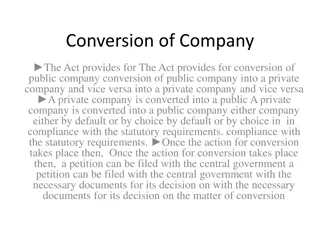
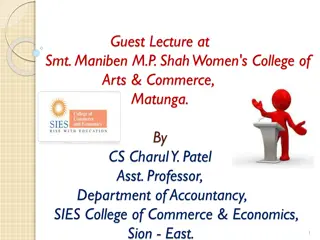
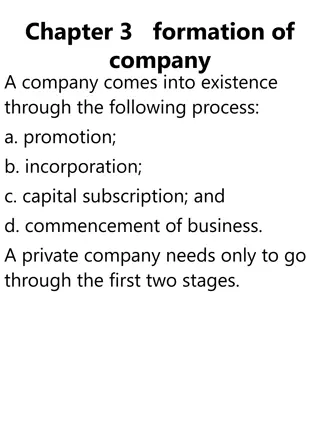

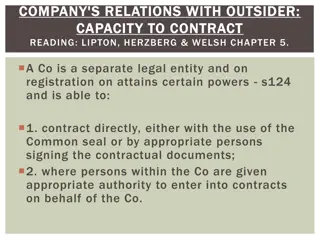

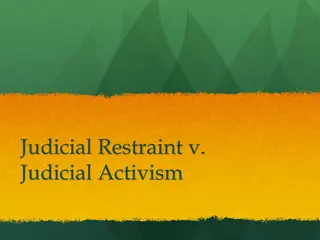

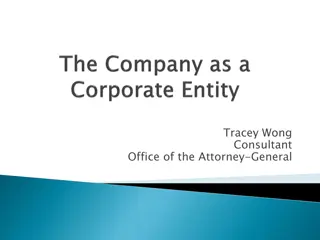
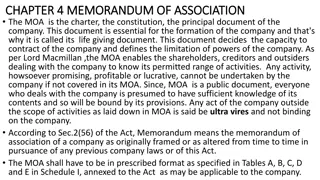

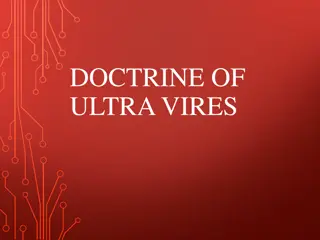

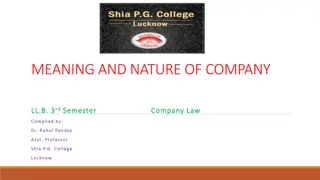

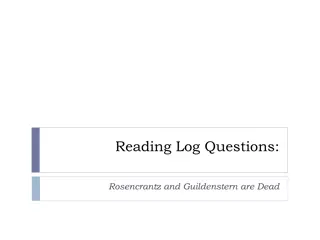



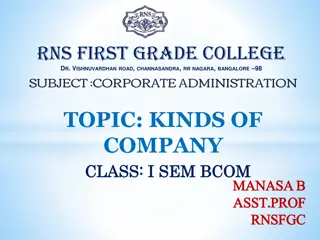
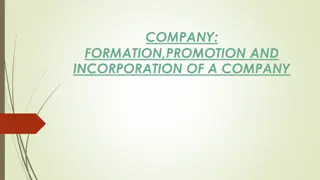
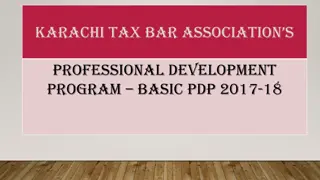



![Year-End Business Report for [Company Name]](/thumb/131798/year-end-business-report-for-company-name.jpg)


